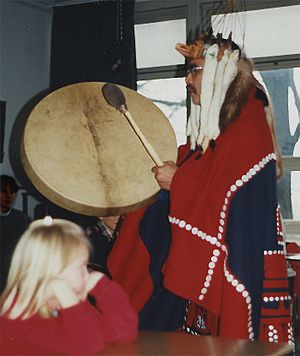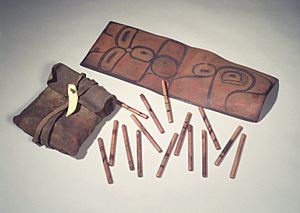Tsimshian facts for kids

Tsimshian drumming in 1999
|
|
| Total population | |
|---|---|
| 8,162 | |
| Regions with significant populations | |
| Canada British Columbia |
5,910 |
| United States Alaska |
2,252 |
| Languages | |
| English • Coast Tsimshian | |
The Tsimshian ( Tsimshian: Ts’msyan) are a group of Native people who have lived along the Pacific Northwest Coast for thousands of years. Their main communities are in coastal British Columbia, Canada, and southern Alaska, United States. You can find them near Terrace and Prince Rupert in British Columbia, and on Annette Island in Alaska.
There are about 10,000 Tsimshian people today. They belong to seven different First Nations groups. These include the Kitselas, Kitsumkalum, and the Allied Tribes of Lax Kw'Alaams. Other groups are the Metlakatla, Kitkatla, Gitga'at at Hartley Bay, and Kitasoo at Klemtu. The Tsimshian are one of the largest First Nations in northwest British Columbia. Some Tsimshian moved to Annette Island, Alaska. Today, about 1,450 Alaska Tsimshian are part of the federally recognized Metlakatla Indian Community. This community is also known as the Annette Island Reserve.
Tsimshian society is based on kinship, which means family ties are very important. It is also matrilineal, so family lines and property pass down through the mother's side. Their society is divided into moieties, which are large groups, and then further into smaller clans.
Long ago, some experts thought the Gitxsan and Nisga'a people were Tsimshian because their languages seemed similar. They were sometimes called "Coast Tsimshian," even if they didn't live on the coast. However, these three groups are actually separate nations.
Contents
Tsimshian History and Origins
The name Tsimshian means "Inside the Skeena River." A long time ago, the Tsimshian lived higher up the Skeena River, near what is now Hazelton, British Columbia. Most Tsimshian people still live in the lower Skeena River area, close to Prince Rupert, and along the northern coast of British Columbia.
According to the stories passed down by the Southern Tsimshian, a chief led his people away from their old land after many problems. They moved to the coast and started Kitkatla Village. This was the first of three Southern Tsimshian villages. Kitkatla is still seen as a very traditional Tsimshian village. The Nisga'a and Gitxsan stayed in the upper Skeena region. But other Tsimshian chiefs moved down the river and settled all the lands in the lower Skeena valley. Over time, these groups developed a new way of speaking their language. They began to see themselves as a unique group, known as the Tsimshian-proper. They still shared traditions with the Gitxsan, their relatives on the upper Skeena.
Before Europeans arrived, the Coastal Tsimshian slowly moved their winter villages to the islands of Venn (Metlakatla). They would return to their summer villages along the lower Skeena River when the salmon came back. Old artifacts show that people have lived in the Prince Rupert area for 5,000 years.
Kitkatla was likely the first Tsimshian village that Europeans visited. Captain Charles Duncan and James Colnett arrived there in 1787. Later, in 1834, the Hudson's Bay Company moved its trading fort to what is now Port Simpson. Because of this, nine Tsimshian villages moved to the nearby area. Many Tsimshian people in Canada still live in these regions today.
Challenges and Changes
In the late 1800s, many Tsimshian communities faced tough times. Diseases brought by Europeans, like smallpox, spread quickly. Native people had no natural protection against these illnesses. Many Tsimshian people died during these outbreaks. About one in four Tsimshian people died in a series of at least three major disease waves.
In 1835, there were an estimated 8,500 Tsimshian people. By 1885, this number had fallen to 4,500. Two years later, 817 of them moved to Alaska.
In the 1880s, an Anglican missionary named William Duncan and a group of Tsimshian people left Metlakatla, British Columbia. They asked the U.S. government for permission to settle on Annette Island. After getting approval, they started New Metlakatla on Annette Island in southern Alaska. Duncan asked the U.S. Congress to make the community an Indian reservation, which happened in the late 1800s.
By 1895, the Tsimshian population in British Columbia was 3,550. The Alaska Tsimshian population dropped to 465 by 1900. After this low point, the Tsimshian population began to grow again. Today, their numbers are similar to the 1835 estimates. However, there are now more inland Tsimshian people than before, while the numbers of Southern and Coastal Tsimshian are much lower.
In the 1970s, the Metlakatla Indian Community in Alaska decided to keep their rights to their land and water. They chose not to be part of the Alaska Native Claims Settlement Act (ANCSA). This means they have the only Native reservation in Alaska. The Annette Islands Reserve is the only place in Alaska where people are allowed to use fish traps. These traps are a traditional way of gathering fish for food. This right was kept because of their old treaty agreements. Other places in Alaska lost this right when Alaska became a state in 1959. The community had to use the traps at least once every three years to keep the right. They stopped using them in the early 2000s and lost this traditional fishing right permanently.
Tsimshian Culture and Traditions

The Tsimshian have a matrilineal kinship system. This means that family lines and property are passed down through the mother's side of the family. Their society is organized into a clan system, which is also called a moiety. Hereditary chiefs got their rights through their mother's family line. Women elders could even remove a chief from power.
Marriage ceremonies were very formal and involved several long steps. There were also certain taboos (rules) about what women and men could eat during and after childbirth.
Like all people of the Northwest Coast, the Tsimshian caught a lot of sea life, especially salmon. Salmon is still a very important food for them, even with large commercial fishing in the area. Because there was so much food, the Tsimshian built permanent towns. They lived in large longhouses made from cedar posts and panels. These houses were very big and usually held an entire extended family.
Tsimshian beliefs focused on the "Lord of Heaven." They believed this being helped people in need by sending special helpers to Earth. The Tsimshian thought that being kind (charity) and cleaning their bodies (purification) through cleanliness or fasting would lead them to the afterlife.
The Tsimshian also take part in the potlatch, which they call the yaawk (feast). Today, potlatches are held at gatherings to honor deaths, burials, and when someone takes on a new name-title.
The Tsimshian people have kept their art and culture strong. They are also working to bring back the use of their language. Historically, the Tsimshian competed with the Tlingit, Haida, Athapaskan groups to the north and east, and Wakashan groups to the south.
Traditional Uses of Plants
Like other coastal peoples, the Tsimshian made most of their goods from western red cedar. They used its bark to make tools, clothing, roofing, armor, building materials, and coverings for canoes. They are also known for inventing Chilkat weaving, which uses cedar bark. They ate the berries of the lingonberry plant.
Tsimshian Tribes
There are fifteen Tsimshian tribes in British Columbia:
- Gitasts'uu, Gidisdzu or Kitasoo (They are part of the Kitasoo/Xaixais First Nation at Klemtu, British Columbia)
- Gitḵ'a'ata, Gitga'ata or Gitga'at (As Hartley Bay Indian Band at Hartley Bay, British Columbia)
- Gitxaała, Gitxaala or Kitkatla (Also known as Git lax m’oon, as Gitxaala Nation they live in the village of Kitkatla, British Columbia)
- Gitsumkalum (Kitsumkalum, British Columbia)
- Gits'ilaasü or Kitselas (Kitselas, British Columbia)
- Allied tribes of Lax Kw'alaams (Port Simpson, British Columbia) including Metlakatla
- Metlakatla, Alaska (This is the newest tribe, with family lines from all Tsimshian tribes)
Tsimshian Clans
The Tsimshian people belong to four main clans:
- Laxsgiik (Eagle Clan)
- Gispwudwada (Killer Whale Clan)
- Ganhada (Raven Clan)
- Laxgibuu (Wolf Clan)
Treaty Process
The Tsimshian wanted to protect their villages and fishing spots on the Skeena River and Nass River as early as 1879. They could not start talking about a treaty with the Canadian government until July 1983. Ten years later, fourteen groups joined together to negotiate as the Tsimshian Tribal Council. They signed a basic agreement in 1997. The Tsimshian nation is still working with the BC Treaty Commission to reach a final agreement.
Tsimshian Language
The Tsimshian speak a language called Sm'algyax, which means "real or true tongue." The Tsimshian also speak a language that is similar to Gitxsan and Nisga’a. These are two other Tsimshianic languages spoken inland. In 2016, only 160 people in Canada spoke Tsimshian.
Some language experts believe Tsimshian languages might be part of a larger group of languages called Penutian.
Notable Tsimshian People

- Frederick Alexcee, artist
- William Beynon, Gitlaan and expert on cultures
- David A. Boxley, Laxsgiik, carver and culture keeper. He was the first to host a potlatch and raise a totem pole in modern times in Metlakatla, Alaska.
- Marcia Crosby, art historian
- Alfred Dudoward, hereditary chief of the Gitando, and a leader of the Port Simpson Methodist Movement. He also helped start the Native Brotherhood.
- Benjamin Haldane, a pioneering photographer from Metlakatla village
- William Jeffrey, Gitwilgyoats, hereditary chief, activist, and carver
- Rudy Kelly, author and journalist
- Paul Legaic, hereditary chief of the Gispaxlo'ots and a trader.
- Odille Morison, translator and art collector
- Rev. William Henry Pierce, missionary and writer
- Peter Simpson, Native American rights activist
- Phil Gray, artist
- Henry W. Tate, Gispakloats, oral historian, and tribal leader
- Roy Henry Vickers, artist
- Arthur Wellington Clah, from the house of Tamks of the Gispaxlo'ots. He was a translator at Fort Simpson and the first to teach Father Duncan the Sm`algyax language. He also kept a diary.
- Walter Wright; hereditary chief of the Gits'ilaasü (Kitselas) and oral historian
Images for kids
-
Bag with 65 Inlaid Gambling Sticks, Tsimshian (Native American), 19th century, Brooklyn Museum
-
Tsimshian bentwood box with formline painting, 1850, collection of the UBC Anthropology Museum
-
Benjamin Haldane, 1907, Tsimshian photographer and musician
See also
 In Spanish: Tsimshian para niños
In Spanish: Tsimshian para niños






